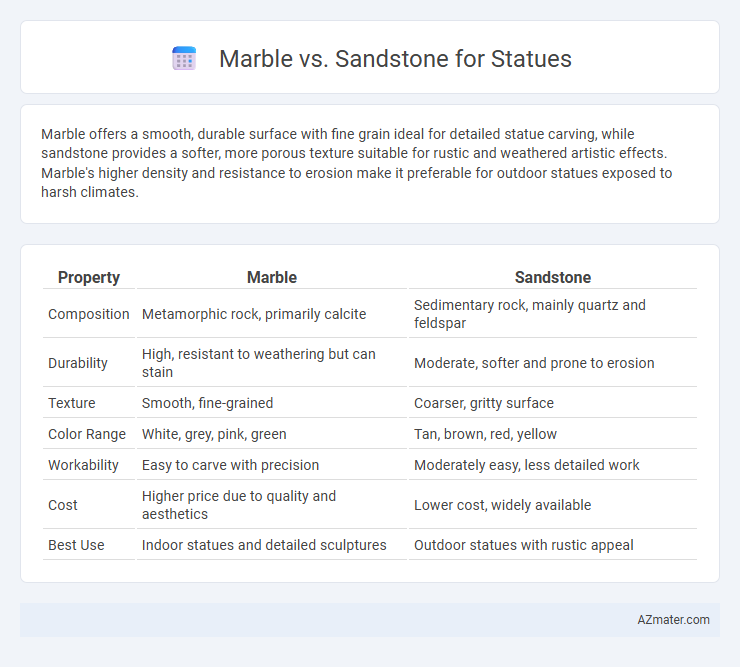Marble offers a smooth, durable surface with fine grain ideal for detailed statue carving, while sandstone provides a softer, more porous texture suitable for rustic and weathered artistic effects. Marble's higher density and resistance to erosion make it preferable for outdoor statues exposed to harsh climates.
Table of Comparison
| Property | Marble | Sandstone |
|---|---|---|
| Composition | Metamorphic rock, primarily calcite | Sedimentary rock, mainly quartz and feldspar |
| Durability | High, resistant to weathering but can stain | Moderate, softer and prone to erosion |
| Texture | Smooth, fine-grained | Coarser, gritty surface |
| Color Range | White, grey, pink, green | Tan, brown, red, yellow |
| Workability | Easy to carve with precision | Moderately easy, less detailed work |
| Cost | Higher price due to quality and aesthetics | Lower cost, widely available |
| Best Use | Indoor statues and detailed sculptures | Outdoor statues with rustic appeal |
Introduction to Marble and Sandstone Statues
Marble and sandstone are popular materials used in statue making due to their unique properties and aesthetic appeal. Marble, a metamorphic rock composed primarily of calcite, offers a smooth, fine-grained texture that allows for detailed sculpting and polished finishes, often seen in classical and Renaissance statues. Sandstone, a sedimentary rock consisting of compacted sand grains, provides durability and a rustic, textured appearance, commonly utilized in outdoor monuments and historical carvings.
Historical Use of Marble and Sandstone in Sculpture
Marble has been a preferred material for sculptures since antiquity due to its fine grain, durability, and ability to achieve intricate details, famously used by artists such as Michelangelo in Renaissance masterpieces. Sandstone, with its softer texture and abundant availability, was widely used in ancient Mesopotamian and Egyptian statuary, providing a warm, earthy aesthetic although it is less durable than marble. The historical use of marble highlights its association with high prestige and longevity, while sandstone's prevalence in early civilizations reflects its practicality and local accessibility.
Physical and Chemical Properties Comparison
Marble, composed primarily of recrystallized calcite, exhibits high density, uniform texture, and excellent compressive strength, making it ideal for fine, detailed statues. Sandstone, consisting of cemented sand grains mainly of quartz and feldspar, has lower density, greater porosity, and is more susceptible to weathering and chemical erosion due to its silica and clay minerals content. Marble's calcite reacts with acids causing surface etching, while sandstone's mineral composition offers moderate chemical resistance but lower durability against freeze-thaw cycles.
Aesthetic Qualities: Color, Texture, and Finish
Marble offers a sleek, polished finish with a smooth texture and a unique veining pattern that enhances the elegance and realism of statues, featuring colors ranging from pure white to shades of gray, pink, and green. Sandstone presents a more rustic, natural texture with a matte finish, displaying warm earth tones like beige, red, and brown that evoke an organic and timeless aesthetic. The choice between marble and sandstone for statues depends on the desired visual impact, with marble providing refined detail and lustrous shine, while sandstone emphasizes a rougher, more grounded appearance.
Durability and Longevity in Outdoor Environments
Marble exhibits superior durability and resistance to weathering in outdoor environments due to its dense, crystalline structure, making it less prone to erosion and chemical damage compared to sandstone. Sandstone, composed of sand-sized mineral grains bound by natural cement, tends to be more porous and susceptible to moisture absorption, leading to faster deterioration and surface flaking over time. For statues exposed to harsh weather conditions, marble generally provides enhanced longevity, maintaining structural integrity and aesthetic appeal longer than sandstone.
Workability for Sculptors: Ease of Carving
Marble offers superior workability for sculptors due to its fine-grained, homogeneous texture, allowing for precise detail and smooth finishes. Sandstone, while softer and easier to carve initially, often contains variable grain sizes and natural impurities that can limit fine detail and increase the risk of chipping. Sculptors prefer marble for intricate statues requiring high levels of detail and durability, whereas sandstone suits larger, less detailed works.
Maintenance Requirements and Care Tips
Marble statues require regular sealing and gentle cleaning with pH-neutral products to prevent staining and etching from weather exposure. Sandstone sculptures need frequent dusting and occasional application of consolidants to protect against erosion and moisture absorption. Both materials benefit from sheltered placement and routine inspections to address potential cracks or surface wear promptly.
Cost Analysis: Marble vs Sandstone
Marble typically costs between $40 to $100 per square foot, making it a more expensive material for statues due to its durability and fine grain texture. Sandstone is generally more affordable, ranging from $20 to $50 per square foot, but it may require more maintenance over time because of its porosity and softer composition. Considering long-term expenses, marble's higher initial cost can be offset by its longevity and lower upkeep compared to sandstone, which may incur frequent restoration costs.
Best Applications for Each Material
Marble is best suited for intricate statues requiring fine detail and a smooth, polished finish due to its density and uniform texture. Sandstone is ideal for larger, outdoor sculptures where durability and weather resistance are important, as its porous nature allows for natural aging and patina development. Choosing marble enhances elegance in indoor or classical art, while sandstone supports rustic and naturalistic designs in exterior settings.
Conclusion: Choosing the Right Stone for Statues
Marble offers exceptional durability and a smooth, polished finish ideal for intricate statue details, while sandstone provides a textured, natural look with easier carving but less resistance to weathering. Selecting the right stone depends on the desired aesthetic, environmental exposure, and longevity requirements of the statue. For outdoor monuments requiring long-term resilience, marble is preferred; sandstone suits indoor or decorative pieces with softer lines and organic appeal.

Infographic: Marble vs Sandstone for Statue
 azmater.com
azmater.com